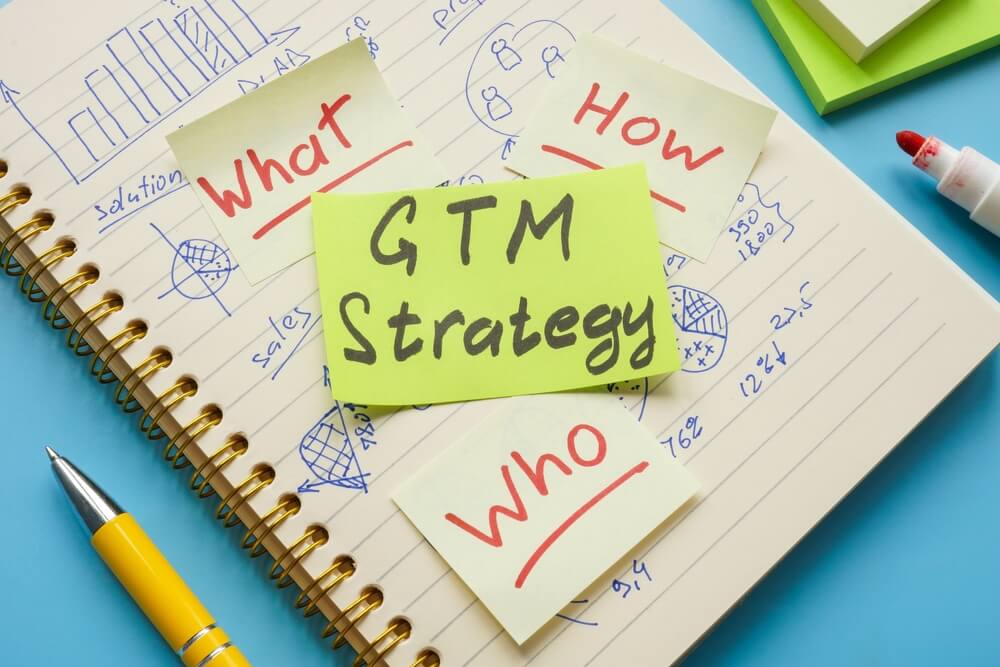
Why Does SaaS Go-To-Market Strategy Matter? How To Build the Perfect Strategy
A software-as-a-service (SaaS) go-to-market (GTM) strategy outlines the plan for bringing a software product to market. It identifies the ideal target audience, pricing, distribution channels, and marketing tactics.
Developing a thorough GTM strategy ensures product-market alignment, establishes a competitive edge, and guides efficient resource allocation. This guide focuses on the following:
- Elements of a GTM strategy.
- How to build the perfect GTM strategy.
A SaaS marketing agency can help create a successful GTM strategy, facilitate a smooth product launch, sustain growth, and overcome the challenges of SaaS marketing. Let’s go!
Want to know how we help SaaS businesses stand out from the crowd? Watch this video to learn how DAP makes it happen!
Elements of a GTM Strategy and Their Importance

As any reliable SaaS marketing agency will tell you, understanding the elements of a GTM strategy helps formulate better and more efficient techniques for SaaS campaigns. Let us learn more about the individual aspects below.
1. Target Audience Identification
Identifying and understanding the target audience includes defining ideal customers' characteristics, needs, preferences, and paths. A well-defined target audience enables precise marketing efforts, which makes the SaaS product resonate with those most likely to convert into paying customers.
2. Value Proposition Development
A compelling value proposition communicates the unique benefits and solutions that the SaaS product offers. It differentiates the offering from competitors and is a foundational element in attracting and retaining customers. A strong value proposition addresses why customers should choose the product over alternatives.
3. Pricing Strategy
Determining the right pricing strategy is critical for enhanced revenue generation and competitiveness. The pricing model should align with the perceived value of the SaaS solution. Whether a SaaS company employs a subscription-based model, tiered pricing, or usage-based charges, its pricing strategy directly impacts customer acquisition and retention.
4. Distribution Channels
Choosing effective distribution channels makes sure that products reach the intended audience. Whether the SaaS company opts for direct sales, online platforms, partnerships, or a combination, selecting the proper channels boosts market reach and accessibility, creating a smooth and efficient distribution process.
5. Marketing and Sales Tactics
Comprehensive marketing and sales tactics create awareness and drive conversions. SaaS companies must utilize digital marketing, content creation, social media, and targeted advertising to engage potential customers. Aligning these tactics with the overall strategy maximizes their impact.
6. Customer Acquisition and Retention
Customer acquisition and retention are pivotal for the SaaS company’s sustained success. Attracting new customers and keeping them satisfied ensures consistent revenue streams. Implementing effective onboarding processes, providing excellent customer support, and incentivizing loyalty reduce churn rates and increase customer lifetime value (CLV).
7. Data Analysis and Iteration
Incorporating data analytics allows continuous monitoring and evaluation of the GTM strategy’s performance. Key metrics such as customer acquisition costs, conversion rates, and qualitative feedback provide valuable insights. Regularly analyzing such data enables informed adjustments, keeping the strategy agile and responsive to market dynamics.
8. Sales Enablement
Equipping the sales team with the necessary tools, resources, and training facilitates effective communication of the product's value. Sales enablement empowers the team to articulate the benefits of the SaaS solution, address customer inquiries, and more efficiently drive conversions.
A well-crafted GTM strategy integrates these elements cohesively, creating a roadmap for successful product launches, sustained growth, and increased market share. Each element builds a strong foundation for customer acquisition, retention, and overall business success.
How to Build the Perfect GTMS

There is no standard formula for creating a GTM strategy, but there are best practices to consider. Here are a few proven techniques to build a great GTM strategy and ensure a successful campaign:
1. Perform Market Research and Segmentation
Market research and segmentation provide a deep understanding of the target audience and market dynamics, which informs an effective SaaS GTM strategy. Thorough research identifies customer needs, preferences, and pain points, helping create a compelling product and messaging.
Tailoring the strategy to specific customer segments optimizes resource allocation and increases the likelihood of successful customer acquisition and retention. Apply these techniques to perform market research and segmentation to create the best GTM strategy:
- Conduct surveys and interviews to gather insights from potential customers about their challenges and expectations for SaaS solutions.
- Analyze SaaS industry competitors to identify market gaps and opportunities for differentiation.
- Effectively segment the audience using demographic and behavioral data, considering factors such as company size and usage patterns.
- Monitor social media platforms for real-time insights into customer discussions and industry trends related to SaaS solutions.
- Leverage data analytics tools to analyze user behavior and engagement metrics on digital platforms.
By combining these strategies, SaaS companies can conduct thorough market research and segmentation, effecting a nuanced understanding of their target audience.
2. Include Value Proposition and Messaging
A SaaS company's value proposition and messaging are crucial in building a GTM strategy. They serve as the foundation for communicating the unique benefits and solutions that the product offers. A well-crafted value proposition clearly articulates how the SaaS solution addresses customer pain points and delivers value, differentiating it from competitors.
Effective messaging makes certain that the target audience understands the relevance of the product, ensuring that it resonates and drives customer engagement and market penetration. The following techniques improve a company’s value proposition and messaging:
- Craft customer-centric messaging highlighting how the SaaS solution addresses the audience's needs.
- Showcase how the product’s unique features solve specific problems or improve processes.
- Keep messaging clear, concise, and jargon-free for easy understanding.
- Customize messages for different customer segments based on market research and segmentation.
- Incorporate storytelling techniques to illustrate the practical applications and real-world impact of the SaaS solution.
- Share success stories, case studies, or testimonials that humanize your company and convey the product’s positive outcomes.
With these strategies, SaaS companies are able to refine their value proposition and messaging, ensuring that they communicate the unique benefits of their product in ways that resonate with their target audience.
3. Develop a Pricing Strategy
Pricing is critical in building a SaaS GTM strategy because it directly influences customer acquisition, revenue generation, and overall competitiveness. The right pricing model warrants that the SaaS product’s market position aligns with customer expectations and perceived value.
A well-crafted pricing strategy maximizes profitability and plays a pivotal role in attracting and retaining customers, contributing significantly to the GTM strategy’s success. Consider the following SaaS marketing agency pricing strategies:
- Base the pricing on the perceived value of the SaaS product, aligning tiers with specific features.
- Implement a freemium model, offering a basic version for free and charging for premium features.
- Create tiered pricing with service levels catering to diverse customer segments.
- Adopt a usage-based pricing model, allowing customers to pay based on their SaaS solution usage.
- Use strategic discounts and promotions to attract new customers, encourage upgrades, or retain users.
Considering these pricing techniques allows SaaS companies to tailor their strategies to meet the diverse needs of their target audience, increase SaaS customer satisfaction, and optimize revenue generation.
4. Decide on Distribution Channels
Distribution channels determine how the product reaches and engages the target audience. Choosing the proper distribution channels makes sure that the SaaS solution is accessible to potential customers according to their preferences.
Whether employing direct sales, online platforms, partnerships, or a combination, the distribution strategy directly impacts market reach, customer acquisition, and overall success. Use the proper distribution channels with the following techniques:
- Utilize direct sales teams or internal representatives to personally engage potential customers.
- Develop strong relationships with prospects, addressing their concerns and guiding their decision-making.
- Leverage online platforms and marketplaces, making the SaaS product easily accessible.
- Form strategic partnerships with businesses, resellers, or agencies to tap into broader customer bases.
- Implement self-service models, allowing customers to sign up and independently use the SaaS solution.
- Develop a robust SaaS content marketing strategy with blog posts, whitepapers, and educational content.
- Implement inbound marketing techniques to attract potential customers and facilitate product discovery.
Integrating these distribution strategies helps SaaS companies diversify their reach, engage customers through their preferred channels, and optimize their GTM strategy to align with the behaviors of their target audience.
5. Enhance Content Marketing and Thought Leadership
Content marketing and thought leadership establish a brand as an authoritative and knowledgeable presence within the industry. Consistent and valuable content positions a SaaS company as a go-to resource, fostering trust and credibility among potential customers.
Thought leadership drives brand awareness and influences decision-makers, contributing to successful customer acquisition and retention in the competitive SaaS landscape. Here are a few approaches to enhance content marketing and thought leadership for the best GTM strategy:
- Develop an educational blog addressing industry challenges and providing how-to guides.
- Produce in-depth whitepapers and research reports on industry trends and best practices.
- Host engaging webinars and virtual events relevant to the SaaS industry.
- Contribute guest articles to reputable industry publications or collaborate with influencers.
- Create interactive content, such as quizzes and infographics, to visually communicate complex concepts.
These strategies establish the SaaS firm’s strong presence as a thought leader, providing valuable insights and building credibility within its industry. These tips also increase brand visibility, attract a qualified audience, and contribute to the success of their GTM strategy.
6. Prioritize Customer Acquisition and Retention
Customer acquisition and retention directly affect revenue growth, market share, and long-term sustainability. Effective customer acquisition ensures a steady influx of new users, expanding the customer base and driving revenue.
Simultaneously, prioritizing retention strategies builds customer loyalty, maximizes CLV, and establishes a foundation for sustained success. Prioritize customer acquisition and retention with these tactics:
- Personalize onboarding according to user preferences to guide them through setup.
- Provide proactive customer support through live chat, email, and a knowledge base.
- Stay connected with users through regular newsletters and updates.
- Encourage engagement with surveys, feedback, and community forums.
- Develop customer education programs with webinars and tutorials.
- Implement loyalty programs with incentives for ongoing engagement.
Finally, work with a marketing agency providing fractional SaaS chief marketing office (CMO) services to develop top-notch customer acquisition and retention campaigns. These services can steer your GTM strategy towards marketing success.
7. Adopt Data-Driven Iteration
Data-driven iteration is crucial in building a SaaS GTM strategy because it allows companies to refine and optimize their approach based on real-time insights and performance metrics.
Analyzing key data points such as customer acquisition costs, conversion rates, and user engagement enables informed decision-making and strategic adjustments. This iterative process ensures that the GTM strategy remains adaptive to market dynamics and aligned with the evolving needs and preferences of the target audience. Consider these best practices:
- Implement performance analytics tools for tracking customer acquisition, conversion, and engagement metrics.
- Use platforms, including Google Analytics, Mixpanel, or Kissmetrics for detailed insights into user behavior.
- Conduct A/B testing on elements of the GTM strategy, including website design, messaging, or pricing.
- Gather customer feedback through surveys using tools, such as SurveyMonkey or Typeform.
- Map the SaaS user journey and identify bottlenecks with tools such as Hotjar or Crazy Egg.
- Monitor and analyze SaaS competitors' strategies for insights and trends.
With these methods, SaaS companies can foster a culture of data-driven decision-making, assuring that their GTM strategy aligns with customer needs, market trends, and the competitive landscape.
Summing Up
SaaS companies can build a comprehensive and effective GTM strategy by integrating the techniques outlined above. These methods facilitate sustainable growth, maximize customer retention, and contribute to the overall success of the SaaS business.
Successful GTM strategies retain subscribers, while failed strategies lose customers. Keep your customers and welcome new ones with a great GTM strategy. Work with the pros. Contact Digital Authority Partners (DAP), the best digital marketing agency for SaaS companies.
Want To Meet Our Expert Team?
Book a meeting directly here




